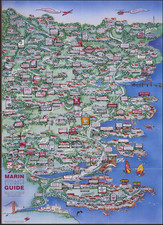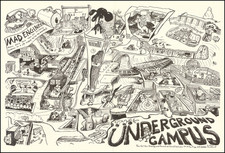Perhaps the First American Map of San Francisco.
Very early American whaler's manuscript map of San Francisco, showing Golden Gate, "San Francisco Village," the Spanish Fort and adjacent boat landing and anchorage, as well as the prime whaler anchorage off Sausalito, accompanied by original soundings.
The map was most likely drawn no later than 1826 to 1828 by the American whaling captain George Crocker of the ship William & Eliza, or provided to him between 1826 and 1828 by an earlier maker. The dating of the map is discussed at length below.
The geography of the map is functional and simple. It is centered on the entrance to the Bay of San Francisco (decades before John C. Frémont would name it the ‘Golden Gate’), including a sightline from the Farallon Islands, the enduring reference point for that dangerous coast. On the southern promontory forming the entrance (i.e., today’s San Francisco Peninsula), we find annotations identifying well-known geographical markers related to the Mexican-era military infrastructure at the Golden Gate entrance, especially El Presidio de San Francisco.
The map was drawn first in pencil and then contemporaneously finished in ink. A note on the back of the map ("Presented By Capt. Crocker of Ship Wm & Eliza New Bed[ford]"), as well as ubiquitous copyist pinpricks, underscores the mode through which scarce but vital hydrographic knowledge was passed among captains before printed charts of the area were available.
A faded pencil note on the verso further illustrates the esprit de corps among the whaling captains of the 1820s: "May success [attend] so that [you/we?] shall not have to go to the [southern/nothern?] part"
On the northern promontory, in today’s Marin County, several notes identifying a watering-place represent one of the earliest depictions of commercial activity in the nascent community of Sausalito. Inside the bay, the Tiburon Peninsula extends into the map from the north, followed by Angel Island, Alcatraz (labeled ‘Rock’), and Yerba Buena Island to the southeast.
The watering-place note reads:
Watering Place - In 5 Fathoms where the Ancor lys best to Anchor on account of A strong current farther off | The Tide walks out here 3 hours before the Tide is [don?] in the Chanel"
San Francisco Village
On the southern side of the Golden Gate, we see the words ‘San Francisco Village’ hand-written across the peninsula. This annotation is remarkable for two main reasons:
Firstly, we must remember that ‘San Francisco’ was as early as 1776 used as a name for the Bay, not the settlement. It wasn’t until some seventy years later, on January 23, 1847, six months after the peaceful surrender of the city as part of the Mexican American War, that Chief Magistrate Washington A. Bartlett announced an ordinance officially renaming Yerba Buena Pueblo as ‘San Francisco.’ In fact, the choice of the name ‘San Francisco’ was in large part motivated by a desire to link the city to the Bay, strengthening its claim as principal port over rival cities like Vallejo or Benicia. The use here is quite unusual, if not unique.
Second, given the time period in question, the label ‘Village’ brings to mind the community around Mission Dolores. But the Mission would be located to the south, outside the geographical scope of the map. The ‘Village’ is instead the presidio itself, which again is a most unusual, if not unique, designation on any map we have come across.
Our hypothesis is that ‘San Francisco Village’ is a loose interpretation of El Presidio de San Francisco. Indeed, the San Francisco portion of our map is a presentation of the structural elements constituting the Spanish and Mexican military presence at the mouth of San Francisco Bay: presidio (‘Village’), fort (‘Fort’), and anchorage (‘Boat Landing’ and anchor symbol).
‘Fort’ refers to the Castillo de San Joaquín, located on the high white cliffs at the entrance to the Bay. The castillo was completed in 1794 and constructed by local Indian labor with imported wood, brick, and tiles. It measured about 34 by 51 meters (112 by 167 feet) and consisted of thick adobe walls, gun emplacements, and a guardhouse. The castillo was strategically positioned to monitor the movement of ships in and out of the Bay, and to guard against possible attacks from the north. The high bluff on which it was situated was known as the Cantil Blanco. It was here that in 1776 Juan Agustín Bautista de Anza had erected a wooden cross to mark formal possession of the region for Spain. The Cantil Blanco was demolished circa 1850 to create room for Fort Point. Today the Golden Gate Bridge passes through where the castillo once stood.
The presidio itself was located to the southeast of the castillo, in an area slightly more protected from coastal weather and supplied by freshwater springs. It was José Joaquín Moraga and pilot and chart maker José de Cañizares who drafted the first plan of El Presidio de San Francisco in 1776. It called for a square building comprised of adobe and brick, about 76 by 76 meters (250 by 250 feet), along with associated buildings. The complex underwent various changes in the following decades, but it maintained its rectilinear form. Astonishingly, the presidio is actually depicted on our map by a small pencil drawing that is decidedly similar to contemporary floor plans from the 1820s.
While primary a martial institution, a full understanding of the presidio’s functions reveals how it might be described as a ‘Village’. It acted not just as the advance guard of territorial settlement, but also provided “the core of governmental, social, and economic activity in the region.” Important visitors and foreign delegations were entertained there. It housed not just soldiers and officers, but also, over time, some of their families. By the 1820s, the presidio had a significantly diminished military role and was under-funded by Mexican authorities. To the casual observer, perhaps for example our mapmaker, the cluster of low adobe huts with thatched roofs probably looked less like a military post than a civilian settlement.
Dating the Manuscript
Records show that George Crocker mastered the Willliam & Eliza twice: first from 1826 to 1828, and again from 1829 to 1831. Crocker was a Nantucket man by birth (c.1800) and had probably been engaged in the whaling industry since his youth. The ship was owned by the Massachusetts agent Joseph Rotch & Co and specialized in the retrieval of sperm whale oil. After captaining the William & Eliza, George Crocker returned to the Pacific on another two whaling expeditions, first in 1832 as captain of the Cambria (1832-1835), and again in 1836 as master of the Young Eagle (1836-1840). When he returned from this expedition in 1840, Crocker bought land in Auburn, Massachusetts, and became a farmer. He died an old man in 1887.
The initial range of 1826 to 1831 can be further narrowed by the map's depiction of the so-called "Presidio Anchorage". On our map, this anchorage is prominently marked as "Boat Landing". A great storm in December of 1824 convinced Mexican authorities that Yerba Buena Cove was a safer anchorage than the earlier Presidio location. The process of supplanting the Presidio Anchorage seems to have involved some overlap for a few years until the Yerba Buena Anchorage was officially recognized in 1828. The map's reliance on the Presidio Anchorage, with no mention of the Yerba Buena Anchorage, strongly suggests that it was made before 1828.
This all makes intuitive sense; Captain Crocker drew or otherwise obtained the map on his first voyage on the William & Eliza, and gave it to someone thereafter.
However, it is possible that Crocker did not draw the map himself, instead obtaining it from someone like William A. Richardson - the founder of Yerba Buena and Sausalito.
Throughout the 1820s, Richardson served as an unofficial anchorage pilot, translator, and general commercial facilitator for ships entering the Bay. As a natural extension, it appears that Richardson also took an interest in mapping, taking depth soundings, delineating shoals and other hazards, and identifying the course of currents and tides. When British navy Capt. Frederick Beechey began the first systematic survey of the Bay in 1826, Richardson spent time on his ship as the local guide (Beechey’s chart would revolutionize the cartography of the region, but would not be published until 1833).
Paper would have been in short supply for a whaling captain such as Crocker, so it's not particularly surprising that his sheet of English laid paper was more than a decade old when the map was probably made (it is watermarked 1813). But the spread in dates between the creation of the paper and Crocker's time in San Francisco leaves open the possibility that the map was made at an earlier date by another maker, such as Richardson.
Conclusion
This document records the geographical context of the first sustained interactions between citizens of the United States and the nascent city of San Francisco. It illustrates the importance of early American whaling voyages in gathering knowledge about North America's west coast and the Pacific generally. And it provides an overview of the first incarnation of what we now call San Francisco. As such, it is one of the most important Western manuscript maps to have come to market in recent years.











![[ Bringing Water To San Francisco ] General Map of the Spring Valley Water Works Hermann F.A. Schussler Chief Engineer. 1899](https://storage.googleapis.com/raremaps/img/small/98206.jpg)


![[ Hayward and San Leandro ] Residence & Architectural Works of Henry Mininger Mt. Eden, Residence and Farm of O. Dennis, & Residence and Farm of F. Hauschildt, Eden Tt., Alameda County, California](https://storage.googleapis.com/raremaps/img/small/102041.jpg)
![[ Spanish Flu -- Masks -- Armistance Day WWI ] The Unveiling of The Kaiser's Finish By Capt. J.F. Mora At Pittsburg, Calif, Nov 17th, 1918.](https://storage.googleapis.com/raremaps/img/small/99630.jpg)
![[Berkeley] This Is The Map of Berkeley Town Its Streets Go Winding Up & Down An Oak-Covered Campus It Wears For A Crown With People & Places of Renown](https://storage.googleapis.com/raremaps/img/small/97201.jpg)